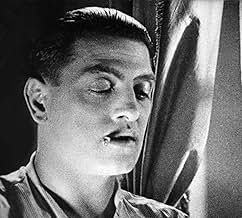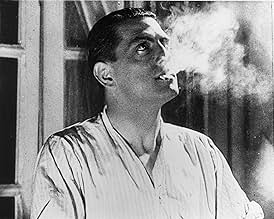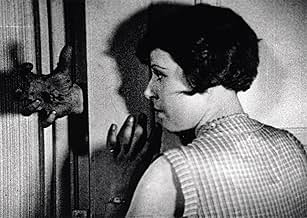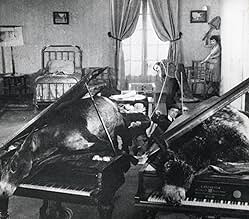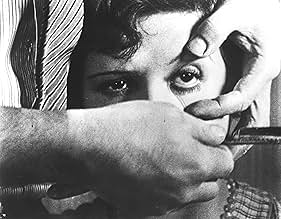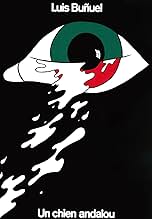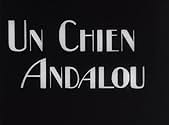CALIFICACIÓN DE IMDb
7.6/10
56 k
TU CALIFICACIÓN
Agrega una trama en tu idiomaLuis Buñuel and Salvador Dalí present 16 minutes of bizarre, surreal imagery.Luis Buñuel and Salvador Dalí present 16 minutes of bizarre, surreal imagery.Luis Buñuel and Salvador Dalí present 16 minutes of bizarre, surreal imagery.
- Dirección
- Guionistas
- Elenco
Pierre Batcheff
- Man
- (as Pierre Batchef)
Simone Mareuil
- Young Girl
- (as Simonne Mareuil)
Luis Buñuel
- Man in Prologue
- (sin créditos)
Pancho Cossío
- Stroller
- (sin créditos)
Salvador Dalí
- Seminarist
- (sin créditos)
Juan Esplandiu
- Stroller
- (sin créditos)
Robert Hommet
- Young Man
- (sin créditos)
Marval
- Seminarist
- (sin créditos)
Fano Messan
- Hermaphrodite
- (sin créditos)
Jaume Miravitlles
- Fat Seminarist
- (sin créditos)
- Dirección
- Guionistas
- Todo el elenco y el equipo
- Producción, taquilla y más en IMDbPro
Opiniones destacadas
I saw this recently n i am shocked at the violent content n nudity in a film made in 1929.
Candyman borrowed the scene where insects come out of a palm.
Candyman borrowed the scene where insects come out of a palm.
This famous film starts in a dream-like sequence, a woman's eye (a cow's eye was actually used) is slit open and juxtaposed with a similarly shaped cloud obscuring . After that , there take place several bizarre events such as a man has a hole in the palm from which ants emerge , it is shown literally ; later on , a man pulls a piano along with the tablets of the Ten Commandments and a dead donkey and two priests being dragged with the piano (a priest is Salvador Dalí) ; a woman pokes at a severed hand in the street with his cane (legend has it that the severed hand used in the street scene was a real hand, and Dali convinced a man to cut it off in exchange for enough money to buy lunch) , among others .
Abstract film that marked strong polemic in the epoch when it was realised , especially its sliced eyeball at the beginning , and still packs a punch even nowadays . In fact , at the Paris premiere, Luis Buñuel hid behind the screen with stones in his pockets for fear of being attacked by the confused audience . After editing the feature , Luis Buñuel and Salvador Dalí didn't know what to do with it , as an acquaintance introduced Buñuel to Man Ray, who had just finished Les Mystères du château Dé and was looking for a second film to complete the program , the two movies premiered together at the Studio Ursulines ; it made a deep impression on the Surrealist Group, who welcomed Buñuel into their ranks . The movie contains several references to Federico García Lorca and other writers of that time . The rotting donkeys are a reference to the novel "Platero y yo" by Juan Ramón Jiménez, which Luis Buñuel and Dalí hated . In 1960, a soundtrack was added to this film at the direction of Luis Buñuel , he used the same music which was played , using phonograph records , at the 1929 screenings-extracts from "Liebestod" from Richard Wagner's "Tristan and Isolde" and two Argentinian tangos.
This rare short belongs to Luis Buñuel's first period and has been voted as one of "The 25 Most Dangerous Movies" . After moving to Paris , Buñuel did a variety of film-related odd jobs , including working as an assistant to director Jean Epstein . With financial help from his mother and creative assistance from Dalí, he made his first film , this 17-minute "Un Chien Andalou" (1929), and immediately catapulted himself into film history thanks to its disturbing images and surrealist plot . The following year , sponsored by wealthy art patrons, he made his first picture , the scabrous witty and violent "Age of Gold" (1930), which mercilessly attacked the church and the middle classes, themes that would preoccupy Buñuel for the rest of his career . That career, though, seemed almost over by the mid-1930s, as he found work increasingly hard to come by and after the Spanish Civil War , where he made ¨Las Hurdes¨ , as Luis emigrated to the US where he worked for the Museum of Modern Art and as a film dubber for Warner Bros . He subsequently went on his Mexican period with "The Great Madcap" , ¨Los Olvidados¨ , ¨The brute¨, "Wuthering Heights", ¨El¨ , "The Criminal Life of Archibaldo De la Cruz" , ¨Robinson Crusoe¨ and many others . And finally his French-Spanish period with notorious as well as polemic films such as ¨Viridiana¨ , Tristana¨ , ¨The Discreet Charm of the Bourgeoisie" and his last picture , "That Obscure Object of Desire" .
Abstract film that marked strong polemic in the epoch when it was realised , especially its sliced eyeball at the beginning , and still packs a punch even nowadays . In fact , at the Paris premiere, Luis Buñuel hid behind the screen with stones in his pockets for fear of being attacked by the confused audience . After editing the feature , Luis Buñuel and Salvador Dalí didn't know what to do with it , as an acquaintance introduced Buñuel to Man Ray, who had just finished Les Mystères du château Dé and was looking for a second film to complete the program , the two movies premiered together at the Studio Ursulines ; it made a deep impression on the Surrealist Group, who welcomed Buñuel into their ranks . The movie contains several references to Federico García Lorca and other writers of that time . The rotting donkeys are a reference to the novel "Platero y yo" by Juan Ramón Jiménez, which Luis Buñuel and Dalí hated . In 1960, a soundtrack was added to this film at the direction of Luis Buñuel , he used the same music which was played , using phonograph records , at the 1929 screenings-extracts from "Liebestod" from Richard Wagner's "Tristan and Isolde" and two Argentinian tangos.
This rare short belongs to Luis Buñuel's first period and has been voted as one of "The 25 Most Dangerous Movies" . After moving to Paris , Buñuel did a variety of film-related odd jobs , including working as an assistant to director Jean Epstein . With financial help from his mother and creative assistance from Dalí, he made his first film , this 17-minute "Un Chien Andalou" (1929), and immediately catapulted himself into film history thanks to its disturbing images and surrealist plot . The following year , sponsored by wealthy art patrons, he made his first picture , the scabrous witty and violent "Age of Gold" (1930), which mercilessly attacked the church and the middle classes, themes that would preoccupy Buñuel for the rest of his career . That career, though, seemed almost over by the mid-1930s, as he found work increasingly hard to come by and after the Spanish Civil War , where he made ¨Las Hurdes¨ , as Luis emigrated to the US where he worked for the Museum of Modern Art and as a film dubber for Warner Bros . He subsequently went on his Mexican period with "The Great Madcap" , ¨Los Olvidados¨ , ¨The brute¨, "Wuthering Heights", ¨El¨ , "The Criminal Life of Archibaldo De la Cruz" , ¨Robinson Crusoe¨ and many others . And finally his French-Spanish period with notorious as well as polemic films such as ¨Viridiana¨ , Tristana¨ , ¨The Discreet Charm of the Bourgeoisie" and his last picture , "That Obscure Object of Desire" .
Luis Buñuel, Calanda, in the province of Teruel in the south of the region called Aragón, a town itself afamed for the twenty-four hour non-stop drums (`la tamborada') in the streets played by hundreds of people together in Holy Week, as a young man fled to Paris with the intention of doing something great in this world. There he met Salvador Dalí who had done the same, leaving his native Catalonia in his mid twenties - some five years younger than Buñuel - with more or less the same ideas in his head.
These two young men, who in later years were to be known - even admired in some cases - as the most extravagant and flamboyant creators of art, were not alone. Pablo Picasso, not yet 50, had already been blazing the trail, to mention another Spaniard among those thronging the avant-garde Paris of the times. Claude Debussy and Maurice Ravel had led the impressionist movement in music for many years, and the `Imagiste' school in poetry was well under way. Anybody who was anybody in the artistic world flocked to Paris, and either made a hit and became someone eminent, or did not.
Cinema was a new art form still to be experimented with; no wonder, then, that these two men of evidently original ideas trying to burst out of them, had to do something so as to gatecrash into the gentry of the established circles of artistes and would-be artistes or hangers-on. The Buñuel-Dalí tandem knew they would produce something different; not necessarily to scandalize anyone, but more with the purpose of attracting attention, whether from intellectuals, artists or their entrepreneurs, or just newspaper editors. Simply following the logical sequence that words can be poetic and an image is worth a thousand words, and that poetry can be abstract, thus so can images, and if they move - better still.
Buñuel got a bit of money out of his mother's purse, and thus the two young men had finance to start on making an abstract poetic sequence which did not pretend to have any logical meaning of any kind. `Un Chien Andalou' was to exist in the same way that any later painting either by Picasso or by Dalí himself would exist without necessarily purporting to mean anything, either significant or insignificant, and without necessarily any implicit objective - far less objective - raison d'etre than simply existing in itself. Whether the result could or should be considered `art' in any quintessential sense is/was up to the pundits, pseudointellectuals, newspaper critics, or anybody else who thought he had any ideas on the matter. Buñuel himself says in his autobiography `My Last Breath' that he would have quite happily burnt the film, but that would not have made any difference anyway.
`Un Chien Andalou' was the only silent film he made; whether because of lack of funds or otherwise intentionally, is hard to say. `L'Age d'Or' one year later had sound; however I cannot help thinking that Buñuel and Dali wanted to make a silent film, which then does not explain why in the 1960s Buñuel chose to add music - Wagner interspersed with a tango, a blatently at-odds combination - which would seem to have been some attempt at being unfaithful to the original. But Buñuel was nothing if not a contradictory person, to say the least. But by the 1960s he was beginning to turn out his best repertoire - `Viridiana' (qv), `Tristana', etc - and maybe his sense of maturity reigned over his other feelings, compelling him to `up-date' the film for newer audiences, even though he might be accused of unloyalty.
But, how does one remain loyal to abstract concepts which defy rationality?
Thus `Un Chien Andalou' remains one of the most misunderstood pieces of art to have ever been made public, and is perhaps the most widely-known short film of all time.
These two young men, who in later years were to be known - even admired in some cases - as the most extravagant and flamboyant creators of art, were not alone. Pablo Picasso, not yet 50, had already been blazing the trail, to mention another Spaniard among those thronging the avant-garde Paris of the times. Claude Debussy and Maurice Ravel had led the impressionist movement in music for many years, and the `Imagiste' school in poetry was well under way. Anybody who was anybody in the artistic world flocked to Paris, and either made a hit and became someone eminent, or did not.
Cinema was a new art form still to be experimented with; no wonder, then, that these two men of evidently original ideas trying to burst out of them, had to do something so as to gatecrash into the gentry of the established circles of artistes and would-be artistes or hangers-on. The Buñuel-Dalí tandem knew they would produce something different; not necessarily to scandalize anyone, but more with the purpose of attracting attention, whether from intellectuals, artists or their entrepreneurs, or just newspaper editors. Simply following the logical sequence that words can be poetic and an image is worth a thousand words, and that poetry can be abstract, thus so can images, and if they move - better still.
Buñuel got a bit of money out of his mother's purse, and thus the two young men had finance to start on making an abstract poetic sequence which did not pretend to have any logical meaning of any kind. `Un Chien Andalou' was to exist in the same way that any later painting either by Picasso or by Dalí himself would exist without necessarily purporting to mean anything, either significant or insignificant, and without necessarily any implicit objective - far less objective - raison d'etre than simply existing in itself. Whether the result could or should be considered `art' in any quintessential sense is/was up to the pundits, pseudointellectuals, newspaper critics, or anybody else who thought he had any ideas on the matter. Buñuel himself says in his autobiography `My Last Breath' that he would have quite happily burnt the film, but that would not have made any difference anyway.
`Un Chien Andalou' was the only silent film he made; whether because of lack of funds or otherwise intentionally, is hard to say. `L'Age d'Or' one year later had sound; however I cannot help thinking that Buñuel and Dali wanted to make a silent film, which then does not explain why in the 1960s Buñuel chose to add music - Wagner interspersed with a tango, a blatently at-odds combination - which would seem to have been some attempt at being unfaithful to the original. But Buñuel was nothing if not a contradictory person, to say the least. But by the 1960s he was beginning to turn out his best repertoire - `Viridiana' (qv), `Tristana', etc - and maybe his sense of maturity reigned over his other feelings, compelling him to `up-date' the film for newer audiences, even though he might be accused of unloyalty.
But, how does one remain loyal to abstract concepts which defy rationality?
Thus `Un Chien Andalou' remains one of the most misunderstood pieces of art to have ever been made public, and is perhaps the most widely-known short film of all time.
Even those who do not like Buñuel's "Un Chien Andalou" will probably never forget it once they see it. It's one of the weirder and more interesting films that you'll ever run across, and even aside from its significance, it would be worth seeing for the distinctive style and material.
It is also very well-crafted, despite its apparently chaotic narrative (or lack thereof). Even when it is impossible to attach meaning to some of the images, it seems clear that it has been filmed almost exactly as Buñuel and Dali intended. Even the music seems to have been chosen deliberately, and at times it complements the images surprisingly well.
While the exact meanings of many of the symbols are probably deliberately obscure, it strongly suggests some general themes such as desire, frustration, and the like. To attempt to analyze it carefully is almost certainly a mistake, and it is probably best taken as a dream or a dream-like series of events without the kinds of obvious connections that one might want to find.
Likewise, it's hard to determine just how good or how important it may be. The extreme disregard of cinema conventions is hard to evaluate now, in that the movie itself established some alternative conventions of a sort. The images themselves are often fascinating, sometimes unsettling or even off-putting, almost always interesting and suggestive.
Perhaps the one thing that can be said about such a movie without much risk of going astray is that almost anyone who has a real interest in cinema or cinema history will (or ought to) want to see "Un Chien Andalou" for himself or herself. Hearing it described by someone else really cannot adequately convey what it is like.
It is also very well-crafted, despite its apparently chaotic narrative (or lack thereof). Even when it is impossible to attach meaning to some of the images, it seems clear that it has been filmed almost exactly as Buñuel and Dali intended. Even the music seems to have been chosen deliberately, and at times it complements the images surprisingly well.
While the exact meanings of many of the symbols are probably deliberately obscure, it strongly suggests some general themes such as desire, frustration, and the like. To attempt to analyze it carefully is almost certainly a mistake, and it is probably best taken as a dream or a dream-like series of events without the kinds of obvious connections that one might want to find.
Likewise, it's hard to determine just how good or how important it may be. The extreme disregard of cinema conventions is hard to evaluate now, in that the movie itself established some alternative conventions of a sort. The images themselves are often fascinating, sometimes unsettling or even off-putting, almost always interesting and suggestive.
Perhaps the one thing that can be said about such a movie without much risk of going astray is that almost anyone who has a real interest in cinema or cinema history will (or ought to) want to see "Un Chien Andalou" for himself or herself. Hearing it described by someone else really cannot adequately convey what it is like.
Good way to sample the filmography of Luis Bunuel is to begin with this surreal short. An excellent intro to Bunuel's more mature work because his films are full of bizarre images that began here. Un Chien Andalou(1929) like the rest of Bunuel's early works experiments with use of film image and surrealism. Illustrates the beginning of a career full of amazing, bizarre, and subversive films. Things could only get better for Bunuel's film career and they did.
Un Chien Andalou(1929) was an artful collaboration between two surrealistic masters in Luis Bunuel and Salvador Dali. These two artists were part of a surrealism movement in Spain that influenced the country's art. Bunuel and Dali had a fruitful but short film partnership that ended once each wanted to go their separate ways. After the early 1930s these talented artists would never work with each other again. For Un Chien Andalou(1929), Bunuel and Dali created images of eccentric force based on their day and night dreams.
Surrealism was very popular in early 20th Century art especially during the 1920s. The surrealist movement took shape in places like France and Spain where it flourished for a period of time before falling apart in 1930s. Un Chien Andalou(1929) is a good example of what made the surrealist movement tick. Salvador Dali designs images with social and symbolic meanings. Bunuel's skills as a surrealist as first shown here would become more abstract once he started mastering his craft.
Plotless short film that is basically a series of images. Un Chien Andalou(1929) is an 'Absolute Film' which relies on abstract imagery in an attempt to unnerve the viewer. In Bunuel's early films, imagery took precedent over things like dialogue and plot. In the history of cinema its a rarity especially since the beginning of the sound era for pure imagery to be the sole existence in a motion picture. Un Chien Andalou(1929) contains images that ranges from the erotic, frightening, funny, strange, and symbolic.
Bunuel's direction for Un Chien Andalou(1929) is very good considering its his first piece of cinematic work as a film director. He uses the same type of dreamlike logic here that prevails in his best films. He directs each image with unlimited imagination. Direction for Un Chien Andalou(1929) may be crude a little unsophisticated but its still fascinating to observe. Luis Bunuel first put his name among the cinematic ranks with the historical important, Un Chien Andalou(1929).
Forever immortalized on celluloid is the eye slicing image of Un Chien Andalou(1929). Cinema's fascination with eye motif probably began here and continued from then on. The destruction of sight is an important them in Un Chien Andalou(1929) and other cinematic works. Jean Vigo remarked in opinion of eye slicing image, "Is it more dreadful than the Spectacle of a cloud veiling a full moon"? Eye slicing image was influential to Italian horror espically to the films of Lucio Fulci and Mario Bava(the former did an updated version of image with eye penetration moment from Zombie Flesh Eaters[1979]).
Caused an enormous scandal in the late 1920s with depiction of disturbing and outright strange imagery. I can picture the reaction of disgust and shock on audiences faces as they watch tongue tied at the images that bombard their senses. Un Chien Andalou(1929) may have lost a little of its shock power by today's standards. Still this short film continues to retain the ability to dare which is an improbability in today's Hollywood cinema. Luis Bunuel's next film, L'Age D'Or(1930) caused an even bigger scandal and riots broke out during the film's opening show.
Not much in the way of substancial acting in a film where characters exist only as impulses and symbols. One of the most important pieces of film during first half of 20th Century cinema. Showed filmmakers that the power to provoke is as important as acting, cinemtography, dialogue, and plot. Un Chien Andalou I think is a forethought to the daring and subversive films of period covering 1967 to 1977. Un Chien Andalou(1929) I feel is the near last of a group of films concerned with film imagery that occupied the silent film genre for twenty plus years.
A motion picture ahead of its time in more ways than one. One reason its ahead of its time is the image of a woman's bare naked breasts being touched by male hands. Image such as one mentioned above was unusual for the period the film was made. Also, there are a couple of images in the film that are on the slightly gory side. Obviously done by a young Bunuel who was more sexually open minded than the older man who though an on screen kiss was obscene.
Bunuel's fetishes and Obsessions that occupied the images of Un Chien Andalou becomes maturely developed in later films. Couple of motifs from Un Chien Andalou shows up in films like Simon del Desierto(1965). Dreamlike imagery of short frequents the stories of El Angel Exterminador(1962) and Belle De Jour(1967). Its a warmup to Bunuel's next film, L'Age D'Or(1930) which is also his first feature length film. Un Chien Andalou(1929) is an exercise in artistic expression and artistic vision by an artistic genius.
Un Chien Andalou(1929) was an artful collaboration between two surrealistic masters in Luis Bunuel and Salvador Dali. These two artists were part of a surrealism movement in Spain that influenced the country's art. Bunuel and Dali had a fruitful but short film partnership that ended once each wanted to go their separate ways. After the early 1930s these talented artists would never work with each other again. For Un Chien Andalou(1929), Bunuel and Dali created images of eccentric force based on their day and night dreams.
Surrealism was very popular in early 20th Century art especially during the 1920s. The surrealist movement took shape in places like France and Spain where it flourished for a period of time before falling apart in 1930s. Un Chien Andalou(1929) is a good example of what made the surrealist movement tick. Salvador Dali designs images with social and symbolic meanings. Bunuel's skills as a surrealist as first shown here would become more abstract once he started mastering his craft.
Plotless short film that is basically a series of images. Un Chien Andalou(1929) is an 'Absolute Film' which relies on abstract imagery in an attempt to unnerve the viewer. In Bunuel's early films, imagery took precedent over things like dialogue and plot. In the history of cinema its a rarity especially since the beginning of the sound era for pure imagery to be the sole existence in a motion picture. Un Chien Andalou(1929) contains images that ranges from the erotic, frightening, funny, strange, and symbolic.
Bunuel's direction for Un Chien Andalou(1929) is very good considering its his first piece of cinematic work as a film director. He uses the same type of dreamlike logic here that prevails in his best films. He directs each image with unlimited imagination. Direction for Un Chien Andalou(1929) may be crude a little unsophisticated but its still fascinating to observe. Luis Bunuel first put his name among the cinematic ranks with the historical important, Un Chien Andalou(1929).
Forever immortalized on celluloid is the eye slicing image of Un Chien Andalou(1929). Cinema's fascination with eye motif probably began here and continued from then on. The destruction of sight is an important them in Un Chien Andalou(1929) and other cinematic works. Jean Vigo remarked in opinion of eye slicing image, "Is it more dreadful than the Spectacle of a cloud veiling a full moon"? Eye slicing image was influential to Italian horror espically to the films of Lucio Fulci and Mario Bava(the former did an updated version of image with eye penetration moment from Zombie Flesh Eaters[1979]).
Caused an enormous scandal in the late 1920s with depiction of disturbing and outright strange imagery. I can picture the reaction of disgust and shock on audiences faces as they watch tongue tied at the images that bombard their senses. Un Chien Andalou(1929) may have lost a little of its shock power by today's standards. Still this short film continues to retain the ability to dare which is an improbability in today's Hollywood cinema. Luis Bunuel's next film, L'Age D'Or(1930) caused an even bigger scandal and riots broke out during the film's opening show.
Not much in the way of substancial acting in a film where characters exist only as impulses and symbols. One of the most important pieces of film during first half of 20th Century cinema. Showed filmmakers that the power to provoke is as important as acting, cinemtography, dialogue, and plot. Un Chien Andalou I think is a forethought to the daring and subversive films of period covering 1967 to 1977. Un Chien Andalou(1929) I feel is the near last of a group of films concerned with film imagery that occupied the silent film genre for twenty plus years.
A motion picture ahead of its time in more ways than one. One reason its ahead of its time is the image of a woman's bare naked breasts being touched by male hands. Image such as one mentioned above was unusual for the period the film was made. Also, there are a couple of images in the film that are on the slightly gory side. Obviously done by a young Bunuel who was more sexually open minded than the older man who though an on screen kiss was obscene.
Bunuel's fetishes and Obsessions that occupied the images of Un Chien Andalou becomes maturely developed in later films. Couple of motifs from Un Chien Andalou shows up in films like Simon del Desierto(1965). Dreamlike imagery of short frequents the stories of El Angel Exterminador(1962) and Belle De Jour(1967). Its a warmup to Bunuel's next film, L'Age D'Or(1930) which is also his first feature length film. Un Chien Andalou(1929) is an exercise in artistic expression and artistic vision by an artistic genius.
¿Sabías que…?
- TriviaAt the Paris premiere, Luis Buñuel hid behind the screen with stones in his pockets for fear of being attacked by the confused audience. Nothing of the sort happened. In fact, the audience loved its mysterious and incomprehensible plot.
- Versiones alternativasThe film was re-released in 1960 with soundtracks.
- ConexionesEdited into Avant-garde Cinema (1960)
Selecciones populares
Inicia sesión para calificar y agrega a la lista de videos para obtener recomendaciones personalizadas
Detalles
- Tiempo de ejecución16 minutos
- Color
- Mezcla de sonido
- Relación de aspecto
- 1.33 : 1
Contribuir a esta página
Sugiere una edición o agrega el contenido que falta


